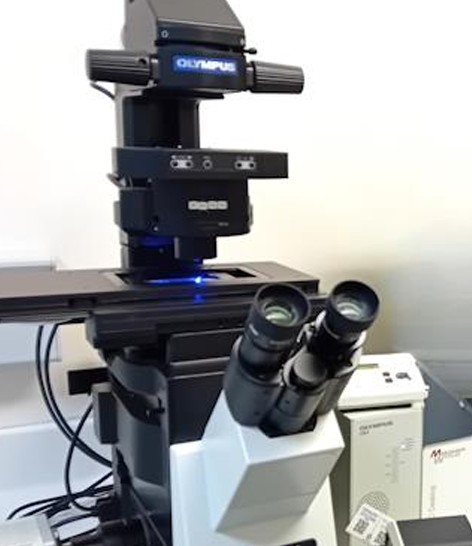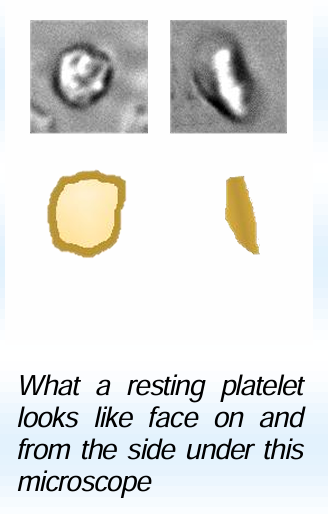Our Component Development and Research Laboratory currently tests samples in a test tube to understand how the collection and storage of blood cells affects their function. With microfluidics we can now look at the way blood cells function after collection in an environment that is closer to the experience in the body. More accurate results will help us to better preserve the quality of blood products resulting in a longer shelf-life, which will in turn benefit patients by ensuring more blood products are available when needed. Using the funding from the SMART Capital Equipment Fund we now have the Olympus 1X83 Automated microscope and software up and running, with the microfluidics components currently in set up.
Micro-hylifeg - Buddsoddiad arloesol yn Gwasanaeth Gwaed Cymru


Mae Gwasanaeth Gwaed Cymru yn camu i fyd ymchwil micro-hylifegol, diolch i gais llwyddiannus i Gronfa Offer Cyfalaf SMART Llywodraeth Cymru. Mae micro-hylifeg yn edrych ar hylifau ar raddfa micrometr, gan ein galluogi i archwilio celloedd wrth iddynt lifo trwy bibellau gwaed efelychiedig mewn ffordd debyg i'r ffordd y mae celloedd yn ymddwyn yn y corff dynol.
Ein prosiect cyntaf
Our first project using the microfluidics kit is around the stickiness of platelets, called platelet adhesion. A principal function of platelets is to form a haemostatic plug at the site of blood vessel injury as an initial step to stop bleeding. The effect of flow is central to this process and microfluidics can be used to simulate platelet adhesion under flow conditions, something that our current methods cannot simulate as accurately. Of particular interest to the Welsh Blood Service is whether platelets stored at refrigerated temperatures retain their ability to stop bleeding. We are currently working alongside civilian and military colleagues to consider this question and we will be able to use microfluidics to look at normal, room temperature stored platelets and the cold stored platelets to assess and compare their clotting potential.

Prosiectau yn y dyfodol
Celloedd coch yw'r rhan o'r gwaed sy'n danfon ocsigen o'r ysgyfaint i'r meinwe, gan deithio o
rydwelïau'r corff i gapilarïau cul sydd ddim ond tua 1/100 milimedr ar draws.
In order to squeeze through the capillaries, red cells need to be able to deform, flexing from their normal disc shape. Damaged or aged cells tend to be too rigid to flex and can block the tiny vessels.Using microfluidics we can make the channels of the chips as small as a capillary and mimic the flow of red cells in the body. This will allow us to assess the effect of storage conditions on the red cells’ ability to deform, informing potential improvements in the manufacture and storage of red cell components. This is particularly relevant in conditions such as sepsis where the microcirculation is already compromised and the ability of transfused red cells to deform may be critical to maintain tissue oxygenation.
Yr arbenigwr microsgopeg
Edward Leech-Sayers is a microscopy specialist and joined the Component Development Research Laboratory at WBS from Cardiff University in November 2023. His extensive experience has been very valuable in setting up the new equipment and providing training to other research staff.
iawn wrth osod yr offer newydd a darparu hyfforddiant i staff ymchwil eraill.

“Mae'r offer microsgop a micro-hylifeg newydd yn ddatblygiad cyffrous mewn technoleg ar gyfer Gwasanaeth Gwaed Cymru. Bydd yn caniatáu inni edrych yn agosach ar sut mae cydrannau gwaed yn ymddwyn wrth iddynt lifo o amgylch y corff dynol. “Byddwn yn gallu bwydo data newydd o ansawdd uchel i’n prosiectau ymchwil ac mae’n agor byd o bosibiliadau ar gyfer ymchwil newydd yn y gwasanaeth gwaed. Mae’n ficrosgop hyblyg iawn y gellir ei ddefnyddio heb y pecyn micro-hylifeg, ac yn bwysig mae ganddo gamera a’r gallu i gofnodi, echdynnu a meintioli data, a rhannu’r hyn rydym yn ei weld. Rwy’n gyffrous i rannu fy nghariad at ficrosgopeg gyda’r tîm yng Ngwasanaeth Gwaed Cymru”
Y cyllid
Roedd cais am grant yn ymdrech tîm a
oedd yn cynnwys arbenigedd Datblygu
Cydrannau Labordy Ymchwil, Gwasanaethau Ymchwil a Datblygu Gwasanaeth Gwaed Cymru a thîm Arloesi Ymddiriedolaeth GIG Prifysgol Felindre.
Dyfarnodd Llywodraeth Cymru dros £112,000 o Gronfa Offer Cyfalaf SMART i sefydlu technoleg micro-hylifegol yn y gwasanaeth gwaed.
Dywedodd Chloe George, Pennaeth Datblygu Cydrannau Gwasanaeth Gwaed Cymru:
“Bydd y cyfleuster newydd hwn yn rhoi gwell dealltwriaeth i ni o nodweddion swyddogaethol ein cydrannau gwaed a allai arwain at welliannau mewn gweithgynhyrchu a storio, mwy o effeithlonrwydd yn y gadwyn cyflenwi gwaed a manteision i bobl Cymru
“Rwy’n credu y byddwn yn gallu ehangu fel sefydliad ymchwil, gan wella sgiliau ac arbenigedd ein gwyddonwyr a’n hymchwilwyr. Wrth i ni archwilio llwybrau newydd ym maes gwyddor trallwyso, byddwn yn cyfrannu mewnwelediadau a datblygiadau gwerthfawr i'r gymuned ryngwladol ehangach.
“Hoffwn ddiolch i Lywodraeth Cymru am eu cefnogaeth drwy fuddsoddi yng ngallu
ymchwil Gwasanaeth Gwaed Cymru.”

